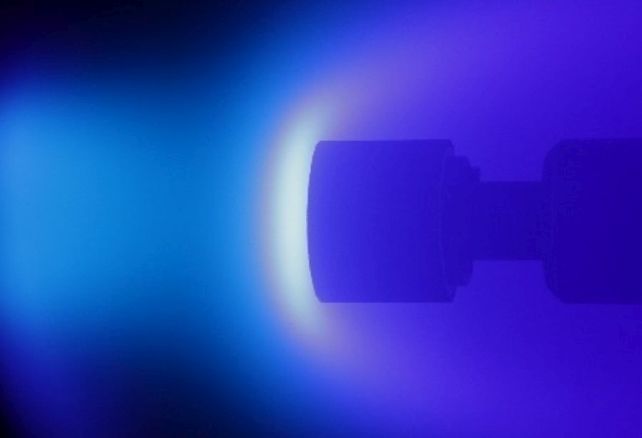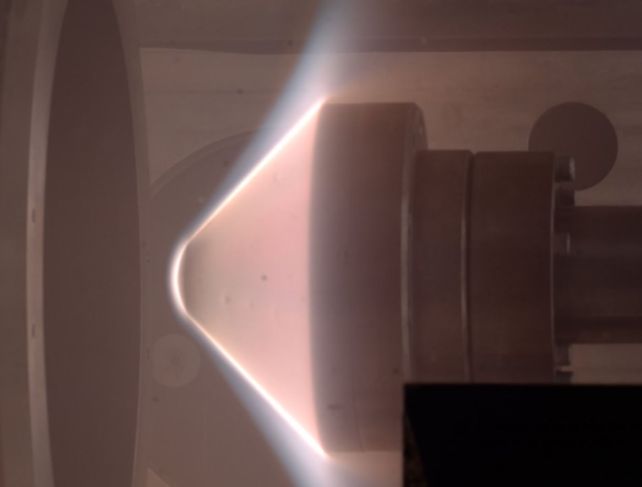Using a high-temperature plasma tunnel, scientists have discovered what it might be like to plumb the depths of Uranus.
Sure, we know it would be smelly; but there are other considerations that need to be taken into account when designing a probe that can withstand the rigors therein. So scientists simulated the atmospheric conditions of the Solar System's distant ice giant and its almost-twin, Neptune, ahead of missions to the two planets that may one day take place.
"The challenge is that any probe would be subject to high pressures and temperatures, and therefore would require a high-performance thermal protection system to endure its atmospheric entry for a useful amount of time," explains aerothermodynamics engineer Louis Walpot of the European Space Agency.
"To begin designing such a system we need first to adapt current European testing facilities in order to reproduce the atmospheric compositions and velocities involved."

Our Solar System's exploration is far from complete. We've had a decent squiz at Mars, and probes around Saturn and Jupiter that have revolutionized our understanding of the gas giants.
We've sent spacecraft to check out Mercury and Venus. But the best inspection Uranus and Neptune have ever received was a passing wave in the 1980s from Voyager 2.
So there's a lot we don't know about the two mysterious outer planets. And scientists from NASA and the ESA are increasing pressure to send a mission out so we can start to fill in some of those glaring knowledge gaps.
The two ice giants are very similar to one another, but there are some intriguing distinctions, such as the difference in their hues due to the way the gasses in their atmospheres are distributed.
In addition, their atmospheres are very different from those of Saturn and Jupiter, so the latter can't really be used as an analog for understanding how those differences play out.

One thing scientists would like to do is send atmospheric probes, similar to the atmospheric entry probe carried by NASA's Galileo mission to Jupiter, to study the atmospheres of the ice giants from within. But, in order to take measurements, and transmit the data back home to Earth, such probes are going to need to withstand the conditions into which they are sent.
Such a probe will travel at speeds up to 23 kilometers (14.3 miles) per second, resulting in high temperatures as it falls through the planets' atmospheres.
So, an international team of scientists from the UK, the European Space Agency, and Germany created a subscale entry probe similar to that of Galileo, and used two different facilities to replicate the conditions: the T6 Stalker Tunnel, a hypersonic plasma facility at Oxford University in the UK, and the plasma wind tunnels of the University of Stuttgart's High Enthalpy Flow Diagnostics Group.
They created atmospheric analogs using mixtures of gasses similar to those found on Neptune and Uranus, and subjected their probe to equivalent speeds up to 19 kilometers per second. The probe then measured the convective heat flux across its surface.

"The [Stalker] tunnel is capable of measuring both convection and radiative heat flux, and critically provide the required flow speeds for the replication of ice giant entry, with traces of CH4 [methane]," Walpot explains.
"The tunnel itself operates with a free-piston driver, which can be coupled to several different components downstream to become a shock tube, reflected shock tunnel or an expansion tube. This adaptability allows for a wide range of testing from subscale modeling testing to the exploration of fundamental high speed flow processes."
Meanwhile, the plasma tunnel at Stuttgart is the only facility in the world that can create the conditions needed to study the effects of ablation and pyrolysis on spacecraft shielding.
Now that the experiments have been successfully performed, researchers can use the information acquired to develop the sensors that will measure the ice giants' atmospheres as they plunge into the mysterious depths. Of Uranus.
